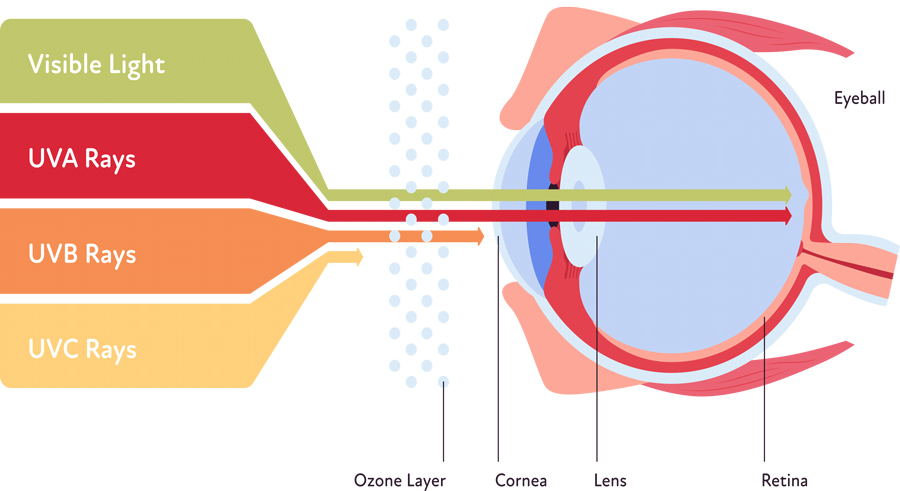The cataract epidemic
Cataracts are caused by lifetime exposure to solar radiation affecting the eye lens and compromising visual ability and everyday activities. It can be treated with surgery; however, due to the increasing number of cataract cases, it is becoming a serious burden in healthcare systems worldwide. Dr Konstantin Galichanin at Uppsala University, Sweden has been studying how ultraviolet radiation leads to cataract development. He hopes his findings can bring us closer to discovering novel drugs for cataract treatment.
Cataract is an eye disease that affects an increasing number of people and is mainly caused by exposure to solar radiation. Although there is mounting evidence that ultraviolet radiation is responsible for cataract development, the pathogenesis of the disease isn’t entirely understood. Dr Konstantin Galichanin at Uppsala University in Sweden has conducted studies to shed light on the mechanisms through which radiation can harm the lens of the eye.

A cataract is a clouding of the lens of the eye. As a result, people with cataracts have a disturbed vision, similar to looking through a frosty window. This makes daily activities more difficult, for example reading, driving a car at night, or even distinguishing facial expressions. Cataract is also the leading cause of blindness in the world; it is responsible for 20 million cases of blindness in both eyes.
The disease develops slowly, usually with ageing, and can be treated with surgery through a generally safe procedure. However, due to the significant number of people affected, cataract surgery has become a considerable economic burden to healthcare systems. Controlling the increase in cataract cases would be beneficial not only to those suffering from the disease but also for healthcare system sustainability, especially as a delay in onset of 10 years would help cut down the need for cataract surgery by an impressive 50%.
The main cause of cataracts
Ultraviolet (UV) radiation has been known to cause disease in humans, including damaging the eye lens, since the 19th century when it was first identified. More recently, epidemiological studies and in vivo experiments in animals have confirmed the causative association between UV radiation and cataract formation.

UV radiation is a form of electromagnetic radiation with a wavelength shorter than that of visible light, ranging from 100 nm to 400 nm. Sunlight is the major source of UV radiation. Solar radiation can be broken down into three forms according to which wavelength spectrum it emits – these are UVR-A (315–400 nm), UVR-B (280–315 nm), and UVR-C (100–280 nm). Contrary to UVR-A, which finds no constraint in reaching the Earth’s surface, or UVR-C that is fully absorbed by the atmosphere, only 10% of UVR-B bypasses the atmospheric gases on its way to the Earth’s surface. That is fortunate for us, as UVR-B can be very harmful and causes skin cancer and sunburn, while lifelong exposure can lead to the development of cataracts.
Cataract damages the eye lens
Cataracts affect the lens of the eye, which is a clear, curved disk that sits behind the iris, the coloured part of the eye. The lens is made mostly of proteins. It works by changing its shape to transmit and focus the light onto the retina to create clear images of objects observed at various distances. Through the gradual breakdown of lens proteins, the characteristic cloudy areas are formed as cataract develops. Cataracts can occur in one or both eyes and interrupt the flow of light through the lens. UVR-B exposure can damage different parts of the lens which can lead to apoptosis, a type of cell death.
Cataract surgery has become a considerable economic burden to healthcare systems.Apoptosis is the programmed cell death that occurs in a coordinated manner by cells that have been damaged beyond repair. Accumulation of apoptotic products and cell debris can be toxic and contribute to cataract development. Through his research, Galichanin is investigating how UVR-B radiation can cause apoptosis in the different parts of the lens tissue. Anatomically, the lens consists of epithelial cells and fibre cells that are both covered by the capsule, a thin membrane around the eye lens. Lens fibre cells comprise the cortex and the nucleus of the lens. Galichanin has shown that the lens epithelium is the first target of UVR-B radiation to be damaged through apoptosis, before the underlying lens fibre cells are affected.

In more detailed follow-up studies, the researcher examined the lens of experimental animals that had been exposed to subthreshold doses of UVR-B radiation, at around 300 nm, for the detection of certain markers that relate to apoptosis.
Galichanin’s investigations can facilitate the discovery of pharmaceutical and other treatments that do not involve costly surgical procedures.Galichanin looked at both mRNA and protein levels of these molecules. mRNA is the product of a gene and is derived during a process called transcription. Proteins are derived from mRNAs through a subsequent process called translation. mRNA levels can be estimated using a technique called qRT-PCR or quantitative real-time polymerase chain reaction. Through sequential cycles of amplification, qRT-PCR enables reliable detection and measurement of mRNA products.

Galichanin looked into both the proteins and mRNAs of p53 and Casp3 genes, which are involved in the process of apoptosis as initiator and executor, respectively. UVR-B can activate p53 which then initiates apoptosis through Casp3. Galichanin wanted to find out in which part of the lens the transcription and translation of p53 and Casp3 happens, to uncover which parts are affected by apoptosis. For apoptosis to happen, detection of proteins is required rather than mRNA alone.
Cell death mechanisms provide hints for treatment
His experiments have demonstrated that a subthreshold dose of UVR-B radiation increases p53 and Casp3 mRNA in both the epithelial and fibre cells of the lens, while their proteins are only increased in the lens epithelium, meaning that minimal exposure to UVR-B radiation causes apoptosis in the lens epithelial cells and not in the fibre cells.
Galichanin’s experiments provide useful information on the estimation of variances in the p53 mRNA levels in tissue. This methodology is based on sample size to assure signal detection. It can be useful in similar studies and could be more broadly applied in biomedical research to advance our knowledge of cataract pathogenesis or other diseases where apoptosis is involved. Moreover, his work on cataract-mediated apoptosis contributes to current knowledge on eye damage during cataract development.

There are different approaches to manage cataract incidence and control its burden on healthcare systems. For one, although cataract is primarily an age-related disease, there are also several risk factors that require attention. Prevention measures should include smoking decrease, limitation to sunlight exposure, and reduction of alcohol consumption to moderate cataract prevalence.
Importantly, studies such as Galichanin’s investigations can facilitate the discovery of pharmaceutical and other treatments that do not involve costly surgical procedures.
Personal Response
What inspired you to conduct this research?My PhD supervisor inspired me to investigate ultraviolet radiation cataract development. His continuous support led to my studies.
How can the study of apoptosis facilitate new drug discovery for cataracts?
By understanding the mechanism of ultraviolet cataract development, including apoptosis, we can facilitate the development of new pharmaceutical treatment of cataracts.